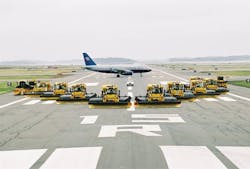Fortbrand Services began in 1983 originally established to serve the ground support equipment (GSE) side of the aviation industry. Today, Fortbrand owns a large inventory of new and used GSE — everything from deicers to pushback tractors to conveyors — available for sale, short-term rental, or long-term lease to airlines, airports, FBOs, ground handling companies, and the military.
The other half of the business is in airfield equipment, says company executive vice president, Alan Stern. Fortbrand is the exclusive North American distributor for two manufacturers — Beam and Hagie; and the exclusive worldwide distributor for Vammas, an airport runway and snow removal equipment manufacturer.
Fortbrand entered into the multi-function equipment arena in the mid '90s, relates vice president Peter Stearn. He comments, "We saw multifunction technology over in Europe where it's been available since the '80s, and thought it could be applied in North America to kind of revolutionize the approach to snow removal at airports here."
Fortbrand's success with the Vammas multifunction equipment lead to other manufacturers seeking the company out to introduce their product to the North American market and the airport community.
Working With Airports
Says Peter Stearn, "Typically what we'll do when we make a sales call on an airport or meet a new airport that we haven't worked with before — we'll get a map of their runway configuration and runway layout, talk to them about the equipment they currently have, how many employees they have available for a shift or a snow event, and then we'll come up with a snow plan for them with what we think is the appropriate amount of equipment for their airport and for their staffing capabilities.
"Once the equipment is delivered, we go on site and train and do dry runs with the equipment on the runways — so it's really a partnership approach where we want to hear all of the challenges the airport is encountering, and help work out what the airport would like to accomplish."
The airport contact with regard to snow removal operations for Fortbrand is typically the airport director of maintenance. With regard to challenges faced by operations and maintenance managers today, "I think the major pressure is cost pressure — so whether it’s having to do more with less personnel, or dealing with tight capital budgets, controlling costs is key," says Alan Stearn.
Peter Stearn agrees, stating, that many airports have indicated they’ve had to delay normal replacement cycles, whereas maybe they replace certain equipment every ten or 15 years, that’s being pushed back by two, three, and four years because budgets have been reduced so dramatically.
As for airport improvement program (AIP) funding, Stearn relates that equipment manufactured in the U.S. is AIP eligible.
Specific Applications
The underlying theme behind the inherent value of multifunctional airfield equipment is in utilizing the equipment for more than one purpose. Multifunctional equipment can bring with it many benefits, including: safety improvements; reduction in amount of labor required; better utilization of human resources; productivity and efficiency improvements; and overall equipment lifecycle cost savings.
Says Alan Stearn, "Our initial strategy was to introduce the equipment to larger airports so we could get high visibility, and the idea was if those airports accepted and endorsed the equipment, that would establish the equipment in the industry and make future sales easier — and that’s exactly what happened.
"We started off with the Vammas snow removal equipment at the Toronto, Boston, and New York area airports, and then added Chicago and Detroit.
"Now more medium-sized and smaller airports are looking at and accepting the multifunction equipment realizing it can do the job faster within more predictable time frames."
Explains Peter Stearn, "At JFK, for instance, they just purchased their second Hagie unit, and they’re talking about aquiring another one — they’ve had some particular problems with bird strikes and they’re going to use the 'flail mower' function more extensively than they had, and also herbicide sprays to diminish the amount of brush and other places that the birds were using for their habitat and breeding grounds.
"With the Beam unit at the Manchester Airport in New Hampshire, they use it practically every day because it's used as a street sweeper on the landside; they use it to clean out their storm drain and storm sewers; they use it as a deicing sprayer — so they love it because of all the functions it can do on a year-round basis."
The Vammas snow removal equipment speaks for itself, says Stearn. "Once airports were able to clean the runways using minimal predictable time frames, and have a consistency in their snow removal operation, they could tell the tower they needed the runway in ten minutes, and the tower could space out aircraft landing rates — it changed the whole nature of that operation."
Equipment Lifespan; Maintenance
With the Vammas snow removal equipment, operators are looking at somewhere around a 15 year-plus lifecycle, says Stearn. The Hagie unit has a ten-12 year lifecycle. The Beam unit depends on the usage by the airport; airports that utilize the equipment for both street and airside can expect shorter lifecycles.
Says Alan Stearn, "Most of the airports maintain their own equipment; they all have trained staff mechanics. One part of our program is training both the operators and the mechanics at the airports so they do a good a job as possible at maintaining the equipment.
Trends
Comments Peter Stearn, "I think that the trend of multifunctionality, or equipment that can be utilized to perform several different functions on a year round basis, will continue.
"If you could find one piece of equipment to do everything, it would be the biggest seller in the world. The trend is going to continue so that airports can have fewer pieces of equipment requiring less manpower.
"The airports come back to us sometimes and say, 'We love this ... is there any way you could add this attachment to it,' or what have you — and we agree that almost anything can be done at a cost, so it’s a matter of filtering the ideas and coming up with things that can be produced and engineered in a cost-effective way.
"I’m sure multifunction equipment is here to stay, it’s just a matter of modifying and tweaking what’s out there."


